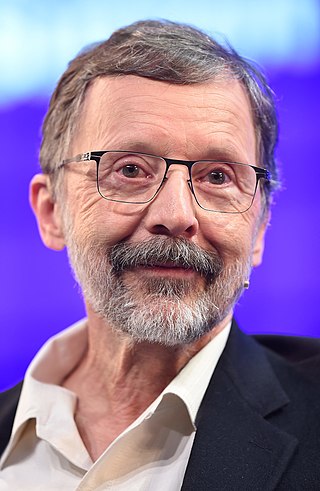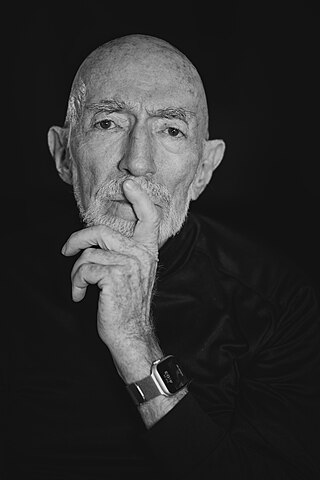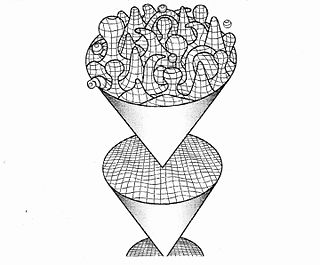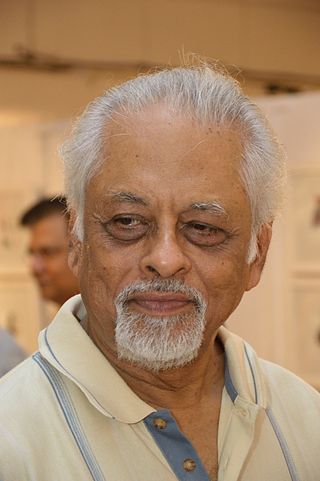Related Research Articles

Physics is the natural science of matter, involving the study of matter, its fundamental constituents, its motion and behavior through space and time, and the related entities of energy and force. Physics is one of the most fundamental scientific disciplines. A scientist who specializes in the field of physics is called a physicist.
Superluminal communication is a hypothetical process in which information is conveyed at faster-than-light speeds. The current scientific consensus is that faster-than-light communication is not possible, and to date it has not been achieved in any experiment.

New Scientist is a popular science magazine covering all aspects of science and technology. Based in London, it publishes weekly English-language editions in the United Kingdom, the United States and Australia. An editorially separate organisation publishes a monthly Dutch-language edition. First published on 22 November 1956, New Scientist has been available in online form since 1996.

A Brief History of Time: From the Big Bang to Black Holes is a book on theoretical cosmology by the physicist Stephen Hawking. It was first published in 1988. Hawking wrote the book for readers who had no prior knowledge of physics.

Edwin Earl Catmull is an American computer scientist and animator who served as the co-founder of Pixar and the President of Walt Disney Animation Studios. He has been honored for his contributions to 3D computer graphics, including the 2019 ACM Turing Award.

The Core is a 2003 American science fiction disaster film directed by Jon Amiel and starring Aaron Eckhart, Hilary Swank, Delroy Lindo, Stanley Tucci, D. J. Qualls, Richard Jenkins, Tcheky Karyo, Bruce Greenwood, and Alfre Woodard.

Kip Stephen Thorne is an American theoretical physicist and writer known for his contributions in gravitational physics and astrophysics. Along with Rainer Weiss and Barry C. Barish, he was awarded the 2017 Nobel Prize in Physics for his contributions to the LIGO detector and the observation of gravitational waves.

Quantum foam or spacetime foam is a theoretical quantum fluctuation of spacetime on very small scales due to quantum mechanics. The theory predicts that at these small scales, particles of matter and antimatter are constantly created and destroyed. These subatomic objects are called virtual particles. The idea was devised by John Wheeler in 1955.

Charles Hard Townes was an American physicist. Townes worked on the theory and application of the maser, for which he obtained the fundamental patent, and other work in quantum electronics associated with both maser and laser devices. He shared the 1964 Nobel Prize in Physics with Nikolay Basov and Alexander Prokhorov. Townes was an adviser to the United States Government, meeting every US president from Harry S. Truman (1945) to Bill Clinton (1999).
Brilliant Light Power, Inc. (BLP), formerly BlackLight Power, Inc. of Cranbury, New Jersey, is a company founded by Randell L. Mills, who claims to have discovered a new energy source from what he says is the electron in a hydrogen atom dropping below its ground energy state into a "hydrino state". The claims lack corroborating scientific evidence and the proposed hydrino states are unphysical and incompatible with key equations of quantum mechanics. BLP has announced several times that it was about to deliver commercial products based on Mill's theories but has never delivered any working product.

Physics World is the membership magazine of the Institute of Physics, one of the largest physical societies in the world. It is an international monthly magazine covering all areas of physics, pure and applied, and is aimed at physicists in research, industry, physics outreach, and education worldwide.

Quantum mysticism, sometimes referred pejoratively to as quantum quackery or quantum woo, is a set of metaphysical beliefs and associated practices that seek to relate consciousness, intelligence, spirituality, or mystical worldviews to the ideas of quantum mechanics and its interpretations. Quantum mysticism is considered pseudoscience and quackery by quantum mechanics experts.

The hypothetical particles tachyons, defined through being faster than light, have inspired many occurrences in fiction. In general, tachyons are a standby mechanism upon which many science fiction authors rely to establish faster-than-light communication, with or without reference to causality issues, as well as a means to achieve faster-than-light travel. Science writer Sidney Perkowitz commented "that the very word "tachyon," because of its unusual Greek-origin spelling and engagingly catchy hard "ch" sound, lends a certain "science-ness" or "science coolness to fiction." Starting in the 1970s, tachyons were used in science-fiction to present a seemingly-plausible explanation for time travel and communication through time. Peter Nicholls, in The Encyclopedia of Science Fiction, describes Gregory Benford's Timescape (1980) as the first work to use tachyons to this effect "with some care", where scientists send a message to the past trying to change history. Glen Cook's 1985 novel A Matter of Time features a much less stringently described "tachyon generator" to "transmit [both to the past and] to the far future". Uses of the concept for space travel appeared in association with "the Asgard, the benevolent alien race in the Stargate SG-1 television series (1997–2007)", and in the 2001 film K-Pax, which coined the term "tachyonic speeds" for "multiples of light speed". An "unabashed" use appeared already in 1969, where "Bob Shaw's The Palace of Eternity features such delights as a million-ton tachyonic spaceship travelling at 30,000 times the speed of light." In the Star Trek franchise, in addition to facilitating faster-than-light travel, tachyons have been mentioned "for varied purposes, including cloaking a spacecraft, detection" of such cloaking and overcoming defensive shields, which has been regarded as "technobabble" by Mashable contributor Keith Wagstaff: dialogue that implies a scientific explanation, using a term with a real scientific concept behind it, "but really doesn't mean much."

The Science & Entertainment Exchange is a program run and developed by the United States National Academy of Sciences (NAS) to increase public awareness, knowledge, and understanding of science and advanced science technology through its representation in television, film, and other media. It serves as a pro-science movement with the main goal of re-cultivating how science and scientists truly are in order to rid the public of false perceptions on these topics. The Exchange provides entertainment industry professionals with access to credible and knowledgeable scientists and engineers who help to encourage and create effective representations of science and scientists in the media, whether it be on television, in films, plays, etc. The Exchange also helps the science community understand the needs and requirements of the entertainment industry, while making sure science is conveyed in a correct and positive manner to the target audience.
IOP Publishing is the publishing company of the Institute of Physics. It provides publications through which scientific research is distributed worldwide, including journals, community websites, magazines, conference proceedings and books. The Institute of Physics is a scientific charity devoted to increasing the practice, understanding and application of physics. Any financial surplus earned by IOP Publishing goes to support physics through the activities of the Institute.
Girish S. Agarwal, Fellow of the Royal Society UK, is a theoretical physicist. He is currently at the Texas A & M University with affiliations to the Departments of Biological and Agricultural Engineering, Physics and Astronomy, and the Institute for Quantum Science and Engineering. Earlier he worked as Noble Foundation Chair and the Regents Professor at the Oklahoma State University. He is a recognized leader in the field of quantum optics and also has made major contributions to the fields of nonlinear optics, nanophotonics and plasmonics. In 2013 he published the textbook "Quantum Optics", covering a wide range of recent developments in the field, which has been well received by the community.
The Nevill Mott Medal and Prize is an award presented in selected years by the Institute of Physics in the United Kingdom, for distinguished research in condensed matter or materials physics. It was first established in 1997 thanks to a donation from Sir Nevill Mott's family. Sir Nevill Mott was one of the outstanding British condensed matter theorists and won a Nobel Prize in Physics in 1977. He died in 1996. The award consists of a silver medal and a prize of £1000.

Partha GhoseFNASc is an Indian physicist, author, philosopher, musician and former professor at the S.N. Bose National Centre for Basic Sciences in Kolkata. He is the former Chairman of Satyajit Ray Film and Television Institute, Kolkata and a member of the Board of Trustees of the Academy of Fine Arts, Kolkata.

Jennifer Ouellette is a science writer and editor, based in Philadelphia, Pennsylvania, and Los Angeles, California.

David Allen Kirby is an American professor of science communication studies at Cal Poly University in San Luis Obispo. He researches, writes about, and teaches science communication and the history of science. He is best known for his work showing how fictional narratives can be used in the process of design and for his studies on the use of scientists as consultants for Hollywood film productions.
References
- ↑ "Sidney Perkowitz". Emory University. Archived from the original on 15 October 2012. Retrieved 6 June 2012.
- ↑ "Roster of Fellows" (PDF). American Association for the Advancement of Science. Archived from the original (PDF) on 6 February 2012. Retrieved 6 June 2012.
- ↑ Perkowitz, Sidney (May–June 1991). "True Colors: Why Things Look the Way They Do". The Sciences: 22–28. doi:10.1002/j.2326-1951.1991.tb02304.x.
- ↑ "Brother Can You Spare a Cyclotron". Technology Review.
- ↑ Perkowitz, Sidney (1997-07-20). "Light Reading". Los Angeles Times. Retrieved 6 June 2012.
- ↑ Perkowitz, Sidney (March 3, 1991). "The War Science Waged". Washington Post.
- ↑ "Sidney Perkowitz: Contributions to Encyclopædia Britannica". Encyclopædia Britannica. Retrieved 6 June 2012.
- ↑ "Big Screen Science". Living on Earth. Retrieved 6 June 2012.
- ↑ "Three films that would make Einstein blush". 2010-02-23. Retrieved 6 June 2012.
- ↑ "Isadora Duncan Foundation Website". Archived from the original on 15 March 2012. Retrieved 20 June 2012.
- ↑ "Doolee Guide to Modern Playwrights and Theater" . Retrieved 20 June 2012.
- ↑ "SCIENTIST SPOTLIGHT: SIDNEY PERKOWITZ". Science and Entertainment Exchange. 8 November 2011. Retrieved 6 June 2012.
- ↑ "Science and Entertainment Exchange". National Academy of Sciences. Archived from the original on 21 June 2012. Retrieved 25 June 2012.
- ↑ "About Sidney | Sidney Perkowitz - Science | Technology | Culture".
- ↑ "Slow Light". Imperial College Press. Archived from the original on 2012-08-22.
- ↑ Hollywood Science. Columbia University Press. December 2007. ISBN 9780231512398 . Retrieved 6 June 2012.
- ↑ Digital People: From Bionic Humans to Androids. Joseph Henry Press/National Academies Press. 2004. doi:10.17226/10738. ISBN 978-0-309-09619-5 . Retrieved 6 June 2012.
- ↑ Universal Foam. Open Library. 2001-10-16. OL 7441854M.
- ↑ Empire of Light . Joseph Henry Press/National Academies Press. 1998. doi:10.17226/6162. ISBN 978-0-309-06556-6 . Retrieved 6 June 2012.
- ↑ Perkowitz, Sidney (February 26, 1989). "Don't Toss Your Old Communications Systems Yet". Miami Herald.
- ↑ Perkowitz, Sidney (March 3, 1991). "The War Science Waged". The Manchester Guardian.
- ↑ Perkowitz, Sidney (March 3, 1991). "The War Science Waged". San Jose Mercury.
- ↑ Perkowitz, Sidney (March 3, 1991). "The War Science Waged". The Houston Chronicle.
- ↑ Perkowitz, Sidney (May 23, 2004). "Hi, Robot". Atlanta Journal-Constitution.
- ↑ Perkowitz, Sidney (2009–2010). "Resistance is Unnecessary: Accepting the Cyborg in our Midst". Literal. 19: 26–27.
- ↑ Perkowitz, Sidney (Spring 2005). "Digital People in Manufacturing: Making Them and Using Them". The Bridge. 35 (1): 21–25.
- ↑ Perkowitz, Sidney (November 28, 1988). "When East Meets West". The Scientist: 9.
- ↑ Perkowitz, Sidney (January 23, 1993). "Spelling it Right in Karachi". New Scientist: 46.
- ↑ Perkowitz, Sidney (Autumn 2000). "Fizzicks!". Times (London) Educational Supplement (Science & Technology.
- ↑ Perkowitz, Sidney (September 2001). "Foamy 'Fizzicks'". Odyssey: 6–11.
- ↑ Perkowitz, Sidney (Winter 1996). "Art Upsets, Science Reassures". Denver Quarterly: 120–131.
- ↑ Perkowitz, Sidney (June 1996). "Connecting with E.M. Forster". The American Prospect: 86–89.
- ↑ Perkowitz, Sidney (September–October 1996). "Mildred Thompson: A Review of Her Retrospective Exhibit". Art Papers: 49.
- ↑ Perkowitz, Sidney (April 2010). "The Six Elements: Visions of a Complex Universe". Leonardo. 43 (2): 208–211. doi:10.1162/leon.2010.43.2.208. S2CID 57568744.
- ↑ Perkowitz, Sidney (2003). Foreword: Between Word and Number. Ithaca, NY: Cornell East Asia Series. pp. ix–xiii.
- ↑ "Slow Light, Softcover, by Sidney Perkowitz, Scientific American Book Club® - sciambookclub.com". www.sciambookclub.com. Archived from the original on 13 December 2011. Retrieved 22 May 2022.
- ↑ "Short takes on three books » American Scientist". Archived from the original on 2012-05-23. Retrieved 2012-05-29.
- ↑ "Gazette | All Things Ornamental: The Arts (July|Aug04)".
- ↑ Barker, G. C. (2000). "PHYSICS: All Kinds of Bubbles". Science. 289 (5478): 398. doi:10.1126/science.289.5478.398. S2CID 118257185.
- ↑ "Nonfiction Book Review: Empire of Light by Sidney Perkowitz, Author Henry Holt & Company $27.5 (240p) ISBN 978-0-8050-3211-6". September 1996.
- ↑ "EMPIRE OF LIGHT by Sidney Perkowitz".